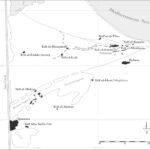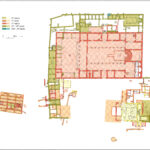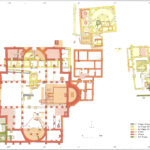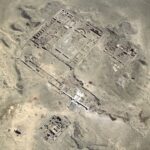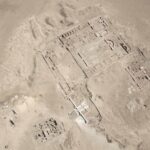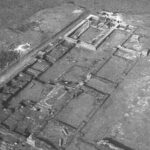TALL AL-FARAMĀ (PELOUSION)
| Egyptian | Pr-ỉr-Ỉmn | Pȝ-ỉ.ỉr-Ỉmn |
| Greek | Πηλούσιον |
| Latin | Pelusium |
| Coptic | peremoun |
| Arabic | تل الفرما |
| English | Pelousion | Pelusium | Tell el-Farama |
| DEChriM ID | 46 |
| Trismegistos GeoID | 1662 |
| Pleiades ID | 727192 | PAThs ID | 36 |
| Ancient name | Pelousion |
| Modern name | Tall al-Faramā |
| Latitude | 31.040445 |
| Longitude | 32.543345 |
| Date from | -500 |
| Date to | - |
| Typology | City |
| Dating criteria | Vast amounts of ceramic ware, but also coinage, etc. |
| Description | The site of Pelusium is situated in north-west Sinai, approximately 40km east of the Suez Canal. Located at the mouth of the Pelusiac branch of the Nile, the site was host to one of Egypt’s busiest ports of the Greco-Roman period, second only to that in Alexandria (Stanley et al. 2008: 451). The site was thus both an important departure point (i.e., for expeditions to Asia), and entry point (i.e., for foreign invaders). Pelusium ‘proper’ is situated on the modern Tall al-Faramā, while the ‘Pelusium conglomerate' extends latitudinally for 4km, including Tall al-Maḫzan and Tall al-Kanāʾis to the east (Grzymski 1997). The origins of the settlement are obscure; majority of the site’s documented history dates from the Persian invasion, while the archaeological work has concentrated predominantly on the Late Roman and Byzantine material, as that is what abounds (Stanley et al. 2008: 451, 453). The site is mentioned as the bishopric of the Meletian Kallinikos from 325, with abundant remnants of Christian material culture uncovered during archaeological fieldwork (Timm 1984-1992: 296). Prominent archaeological features include a military fort, a roman theater, a temple dedicated to Zeus-Casios, a possible hippodrome, public houses, and thermal baths, in addition to five churches (three of which comprise the vast pilgrimage complex of Tall al-Maḫzan). The Roman fort is undoubtedly the most domineering structure (Abd el-Maksoud et al. 1994; id 2001). Made of red brick, it is dated to the sixth century, with such a late date leading one to assume that the monumental structure was constructed atop of earlier deposits (Jakubiak 2019: 113). To the north of the fort, near the northern enclosure wall, is a small bath complex, presumably datable to the third century CE (Abd el-Maksoud 1984-1985; Abd el-Maksoud and Wagner 1989). The second-most dominant archaeological feature is the ‘Great Theater’, located east of the fortress. Understood to date from the second-third century CE, the structure has been the key focus of the joint Polish-Egyptian mission (Jakubiak 2008b: 224; id 2013: 570). The discovery of rubbish dumps under the theater, containing Ptolemaic ceramic, indicates that, in earlier phases of occupation, the area of the theater was outside the city limits. Deposits identified underneath the western entrance to the theater appear to belong to a bathing complex, dating from the first century CE (Jakubiak 2019: 109). To the north and north-east of the theater are residential quarters, some of which appear to have belonged to relatively wealthy families. The most distinctive evidence for this is a house in the northern sector of the northern residential area (sector 2), which contained a decorated floor mosaic, with a terminus post quem in the first half of the fourth century (Jakubiak 2008a: 115). Retrieved from the same house were three amphora stoppers stamped with Latin inscriptions, two of which included Christograms, and a large quantity of fourth century coins (Jakubiak 2008a: 117; Jakubiak 2019: 116). The residential structures spread towards the east along two columned streets comprising the main arteries of the city, with electro resistance and magnetromic research indicating that the streets of Pelusium formed a regular Hippodamus grid plan (Jakubiak 2019: 116, 118). Underneath the city’s streets, a remarkably well-preserved sewage system was identified, the oldest parts of which are considered to date back to the Ptolemaic period (Jakubiak 2019: 110). Additional structures of interest are located to the south-west of the Great Theater, comprising a somewhat confusing amalgam of structures, one of the earliest of which was a suburban villa, datable to the late third century, part of which seems to have operated as a monetary workshop (Bonnet et al. 2006: 372). A room belonging to this villa was transformed into an oratory in mid-fourth century (as indicated by amphoras and coins minted under Constantius II; Bonnet et al. 2007: 250-252; Dixneuf 2007: 265-269; Dixneuf 2011: 65), which then formed the nucleus of a monumental tetraconch church constructed in the early fifth century, with the oratory being integrated into the northern apse (Bonnet et al. 2008: 126; Bonnet et al. 2009: 142). The villa seems to have been in partial operation at the time of the church’s construction (Bonnet et al. 2009: 142). Underneath the church, a potter’s workshop datable to the fourth century was uncovered (Bonnet et al. 2009: 142). To the east of the church, a bathing complex was revealed, with associated coins ranging from the first century BCE to the fourth century CE, but the earliest phase of the baths themselves seems to be the end of the third century CE (Bonnet et al. 2008: 125). Near these baths is an additional structure suspected to have been a gymnasium, presumed to be that mentioned in a second century CE inscription re-used in the tetraconch church (Carrez-Maratray 2006; Łajtar, A. 2007; Bonnet et al. 2008: 122; Bonnet et al. 2009: 135). The initial funerary function of the church is attested to via the presence of at least four locations intended for sarcophagi, as well as a number of east-west oriented graves in the floor. This has led to the interpretation of the structure as a familial mausoleum, likely related to the owner of the earlier residential structure (Bonnet et al. 2006: 373-374, fig. 1; Bonnet et al. 2008: 126; Bonnet et al. 2009: 142). The second phase comprised a number of architectural modifications, while in the third phase, at the beginning of the sixth century, a number of chapels and two baptisteries were added (Bonnet et al. 2006: 375-376). The whole structure was destroyed in either the mid-sixth or perhaps seventh century (Bonnet et al. 2006: 376). The western area of Pelusium has seen the least exploration. In addition to the Temple of Zeus Casios, identified by J. Clédat (Clédat 2013: 79-85), and a possible hippodrome, identified by the Canadian team (Jakubiak 2019: 111; Grzymski 1997), the area is host to a rotunda church, datable to the second half of the fifth century. Excavated in the 90s, the structure includes a crypt/martyrion, accessible via two symmetrical sets of stairs, in addition to a cruciform baptismal font (El-Taher and Grossmann 1997; Grossmann and Hafiz 2001; Grossmann 2002: 471). To the east of the possible hippodrome, an industrial quarter was identified (Abd el-Maksoud et al. 2001).
Tall al-Maḫzan A great deal of what is known about Pelusium derives from the work conducted at Tall al-Maḫzan, a pilgrimage complex located east of Tall al-Faramā. The area includes three churches, in addition to a number of hydraulic installations in the south-west (baths and latrines) and cooking installations, all of which were intended to accommodate the visitors. The complex is constructed atop of a cemetery, indicating that the area was originally situated outside the city limits and that the burial of an important figure likely acted as the impetus for the construction of the complex. According to textual sources, the body of St. Epimachus was transferred here in the fourth century, though whether this burial acted as the original core is uncertain (Carrez-Maratray 1999: 156; Grossmann 2002: 472; Bonnet et al. 2004a: 47; Bonnet et al. 2005: 281). Work in the area began in the mid-90s under the direction of M. Abd el-Sami, whose doctoral thesis was concentrated on the central church, the large basilica (Abd el-Sami 1999). South Church To the north of the church, in-between it and the basilica, are numerous burials, including those of newborns and very young children interred in amphorae. All these burials were disturbed, apart from a few rare instances which contained material datable to the late fourth and fifth centuries, including a fourth-century amphora used for one of the aforementioned infant interments (Bonnet and Abd el-Sami 2000: 77; Bonnet and Abd el-Sami 2003: 81; Bonnet et al. 2004a: 56, 58; Dixneuf 2004: 63-64; Dixneuf 2011: 66-67). Certainly not all these burials should be interpreted with relation to the churches, however, given the fact that the area operated as a cemetery in earlier periods, with Ptolemaic material also having been found (Bonnet and Abd al-Sami 2000: 69). Large Basilica and Northern Church The construction of the church can be understood in relation to an increase in popularity of the location as a place of pilgrimage, necessitating the expansion of the complex, in addition to the development of facilities to accommodate for the visitors (Bonnet et al. 2005: 283). These facilities included an area dedicated to the production of food stuffs (an olive press, bread ovens etc.), in addition to modifications made to the latrines, and the construction of thermal baths, much of which was concurrent with the fifth century construction of the basilica church (Bonnet and Abd el-Sami 2003: 84, 87; Bonnet et al. 2004a: 54; Bonnet et al. 2005: 286). The third, and latest, church is situated to the north of the basilica, with an associated baptistery and burial area. Given that construction of the basilica was finalised in the sixth century, the construction of this later church (and associated northern quarter) can be situated in the second half of the sixth century, with modifications in the seventh century (Bonnet et al. 2004a: 52). |
| Archaeological research | The first documented archaeological exploration of the ruins of ancient Pelusium were those of A. H. Sayce in 1887, but these results were never published (Timm 1984-1992: 932). Further exploration was conducted under the direction of Flinders Petrie (Flinders Petrie et al. 1888: 99-101), but the most substantial early exploration was that of J. Clédat in 1910 (Clédat 1913; id 1915; id 1923). Once the Sinai was back in the possession of Egypt, work was conducted in the 1980s by M. Abd el-Maksoud, with J.-Y. Carraz-Marratray. In the early 1990s, plans for the construction of the Salam (‘Peace’) Canal necessitated the initiation of a large-scale salvage mission geared towards the collection of data from sites which would have been destroyed by the construction, and to potentially re-direct certain stretches of the canal in order to maintain the integrity of archaeological remnants. Under the aegis of the North Sinai Salvage Project, Tall al-Faramā was the largest, and most important site involved in this salvage work. As a result of its size, the various areas of the site were divided into independent concessions and allocated to teams from Egypt, Canada, Switzerland and Britain. The Western part of Pelusium was investigated by a joint Canadian-Egyptian mission, directed by K. Grzymski, which saw two seasons of work (1993-1994), with only limited output (Grzymski 1997). The southern area of the site was the concession of the British under the direction of S. Snape. Like the Canadian mission, the work was brief, with four seasons having been conducted and resulting in a limited scientific output (Snape and White 1996). Majority of the work to have been conducted at the site was that in the east by the Swiss, who, in collaboration with the Egyptians, have concentrated on Tall al-Maḫzan (in addition to limited surveys of Tall al-Kanāʾis). Initially part of the salvage mission, in 2006 the work developed into a program titled “Farama Southeast Zone”, under the co-direction of M. Abd el-Maksoud (SCA) and Ch. Bonnet, assisted by J.-Y. Carraz-Marratray (French-Swiss). This work has been on hold since 2010. In 2003, the Polish Centre of Mediterranean Archaeology and the Institute of Archaeology of the University of Warsaw accepted an invitation from the SCA to participate in a joint mission, which lasted until 2006 (with “at least five” seasons of excavation) (Jakubiak 2019: 109). The mission, which concentrated on the theater in the center of the settlement, developed upon the work instigated on the structure by the SCA in the 1990s (Abd el-Maksoud et al. 2003). Although the mission was collaborative, the work was structured in such a way so that the Polish and Egyptian teams worked independently. The main aim of this work was the creation of a plan for the protection and basic reconstruction of the building. The Polish team was directed by M. Gawlikowski, followed by K. Jakubiak, while the Egyptian team was directed by A. Samiya and A. Taba’i. A number of geophysical prospections have been conducted on the site, first in the 1990s by various Egyptian universities (Ibrahim et al. 1998), followed by T. Herbich in 2008 and 2009, as part of the Polish-Egyptian mission. In 2019, an independent Egyptian archaeological mission revealed a large Greco-Roman building (c. 2500 square meters), though very limited information is available about this. |
• Abd el-Maksoud, M. 1984-1985. “Preliminary Report on the Excavations at Tell Farama (Pelusium), First Two Seasons (1983/4 and 1984/5).” Annales du Service des antiquités de l'Égypte 70: 3-8.
• Abd el-Maksoud, M. and J.-Y. Carrez-Maratray. 1988. “Une inscription grecque de la forteresse de Péluse.” Cahiers de recherches de l’Institut de papyrologie et d’égyptologie de Lille 10: 97-103.
• Abd el-Maksoud, M. A. el-Taba'i and P. Grossmann. 1994. “The Late Roman Army Castrum at Pelusiam (Tall al-Farama).” Cahiers de recherches de l’Institut de papyrologie et d’égyptologie de Lille 16: 95-103.
• Abd el-Maksoud, M., A. el-Taba'i and P. Grossmann. 2001. “New Discoveries in Pelusium (Tell al-Farama) a Preliminary Report.” Bulletin de la Société d’archéologie copte 40: 11-20.
• Abd el-Maksoud, M., A. el-Taba'i and P. Grossmann. 2003. “The Great Theatre of Pelusium.” In Hommages à Fayza Haikal, edited by N. Grimal, A. Kamel and C. May-Sheikholeslami, 271-283. Cairo: Institut français d’archéologie orientale.
• Abd el-Maksoud, M. and G. Wagner. 1989. “L’inscription grecque du grand bain roman de Péluse.” Cahiers de recherches de l’Institut de papyrologie et d’égyptologie de Lille 11: 135-138.
• Abd el-Sami, M. 1992. “Preliminary Report on the Excavation at Tell al-Makhzan (Pelusium).” Cahiers de recherches de l’Institut de papyrologie et d’égyptologie de Lille 14: 91-95, pl. 5-8.
• Abd el-Sami, M. and J.-Y. Carrez-Maratray. 1998. “L’église de Tell El-Makhzan à Péluse.” In Le Sinai durant l’antiquité et le Moyen-âge, 4000 ans d’histoire pour un désert, Actes du Colloque « Sinai » qui s’est tenu à l’UNESCO du 19 au 21 septembre 1997, edited by D. Valbelle and Ch. Bonnet, 127-132. Paris: Errance.
• Abel, F. M. 1940. “Les Confines de la Palestine et de l’Égypte sous les Ptolemées.” Revue biblique 49 : 55-57, 224-239.
• Al-Taba’i, A., M. Abd al-Maksoud and P. Grossmann. 2003. “The Great Theater of Pelusium.” In Hommages à Fayza Haikal, edited by N. Grimal, A. Kamal and C. May-Sheikholeslami, 271-283. Cairo: Institut français d’archéologie orientale.
• Al-Taher, R., M. Abd al-Hafiz and P. Grossmann. 2002. “Excavation and Restoration of the SCA-Islamic Section of the Church Complex of Tall al-Makhzan (Pelusium).” Bulletin de la Societé d’achéologie copte 41: 33-39.
• Amélineau, E. 1890. La géographie de l’Égypte à l’époque copte, 318-319. Paris: Imprimerie Nationale.
• Aziz, A. M., W. A. Sauck, H. S. El-Arabi, M. A. Rashed and M. A. El-Maksoud. 2013. “Application of Analytic Signal and Euler Deconvolution in Archaeo-Magnetic Prospection for Buried Ruins at the Ancient City of Pelusium, NW Sinai, Egypt: A Case Study.” Surveys in Geophysics 34, 4: 395-411.
• Bonnet, Ch. 2011. “Topographie chrétienne de l’antique Péluse (Farama) en Égypte.” In Architecture paléochretienne, edited by J.-M. Spieser, 60-75. Gollion.
• Bonnet, Ch. and M. Abd el-Sami. 1998. “L’église basilicale de Tell el-Makhzan. État de la question en 1997.” Cahiers de recherches de l’Institut de papyrologie et d’égyptologie de Lille 19: 45-56.
• Bonnet, Ch. and M. Abd el-Sami. 2000. “Les églises de Tell el-Makhzan, La campagnes de fouilles de 1998 et 1999.” Cahiers de recherches de l’Institut de papyrologie et d’égyptologie de Lille 21: 67-96, pl. 9-14.
• Bonnet, Ch. and M. Abd el-Sami. 2003. “Les églises de Tell el-Makhzan, La campagne de fouilles de 2001.” Cahiers de recherches de l’Institut de papyrologie et d’égyptologie de Lille 23: 75-93.
• Bonnet, Ch. and M. Abd el-Sami. 2004. “Les églises de Tell el-Makhzan, La campagne de fouilles de 2002.” Cahiers de recherches de l’Institut de papyrologie et d’égyptologie de Lille 24: 15-33.
• Bonnet, Ch., M. Abd el-Sami, M. Ab del-Hafez and R. el-Taher. 2004a. “L’ensemble religieux de Tell el-Makhzan. Les campagnes de fouilles de 2003 et 2004.” Cahiers de recherches de l’Institut de papyrologie et d’égyptologie de Lille 24: 47-60.
• Bonnet, Ch., M. Abd el-Sami, M. Ab del-Hafez and R. el-Taher. 2004b. “L’ensemble martyrial de Tell el-Makhzan à Péluse en Égypte.” L’Archéologie 75: 26-29.
• Bonnet, Ch., M. Abd el-Sami and A. El-Tabie. 2004. “L’église cruciform tétraconque de Farama suf à Péluse (Égypte).” L’Archéologie 73: 31-33.
• Bonnet, Ch., M. Abd el-Sami, F. Tahla, R. Al-Taher, M. Abd al-Hafez, N. Ouda Mohamed, D. Dixneuf and Fr. Delahaye. 2005. “L’ensemble martyrial de Saint Épimaque à Tell al-Makhzan (Égypte – Nord Sinaï).” Geneva 53: 281-305.
• Bonnet, Ch., M. Abd el-Sami, C. Simon, P. Ballet, V. Bardel and J.-Y. Carrez-Maratray. 2000. “Les églises de Tell el-Makhzan, Les campagnes de fouilles de 1998 et 1999.” Cahiers de recherches de l’Institut de papyrologie et d’égyptologie de Lille 21: 67-96.
• Bonnet, Ch., M. Abd el-Sami, F. Talha, R. Al-Taher, M. Abd el-Hafiz, M. O. Mohamed, D. Dixneuf and F. Delahaye. 2005. “L’Ensemble martyrial de Tell Makhsan en Égypte.” Genava 53: 281-291.
• Bonnet, Ch., J.-Y. Carrez-Maratray, M. Abd el-Samie, A. el-Tabai, F. Delahaye and D. Dixneuf. 2006. “L’église tétraconque et les faubourgs romains de Farama à Péluse (Égypte – Nord Sinaï).” Genava 54: 371-384.
• Bonnet, Ch., J.-Y. Carrez-Maratray, M. Abd el-Samie and A. el-Taba’i. 2007. “l’église tétraconque, l’oratoire et les faurbourgs romains de Frama à Péluse (Égypte – Nord Sinaï).” Genava 55 : 247-260.
• Bonnet, Ch., J.-Y. Carrez-Maratray, M. Abd el-Samie, A. el-Tabaie, Fr. Delahaye and D. Dixneuf. 2006. “Les fouilles de Tell el-Farama à Péluse (Égypte – Nord Sinaï).” Genava 54: 371-397.
• Bonnet, Ch., J.-Y. Carrez-Maratray, M. Abd el-Samie, A. el-Tabaie, Fr. Delahaye and D. Dixneuf. 2007. “Les fouilles archéologiques de Tell el-Farama à Péluse (Égypte – Nord Sinaï) en 2007.” Genava 55: 247-270.
• Bonnet, Ch., J.-Y. Carrez-Maratray, M. Abd el-Samie, A. el-Tabaie, Fr. Delahaye and D. Dixneuf. 2008. “L’église tétraconque et la villa suburbaine des faubourgs de Farama à Péluse (Égypte – Nord Sinaï).” Genava 56: 121-143.
• Bonnet, Ch., J.-Y. Carrez-Maratray, M. Abd el-Samie, A. el-Tabaie, Fr. Delahaye and D. Dixneuf. 2009. “Le temple des faubourgs de l’antique Péluse et l’église tétraconque de Tell el-Farama (Égypte – Nord Sinaï).” Genava 57: 135-165.
• Bonnet, Ch., J.-Y. Carrez-Maratray, M. Abd el-Samie, A. el-Tabaie, Fr. Delahaye and D. Dixneuf. 2010. “Les fouilles archéologiques de Tell el-Farama (Égypte – Nord Sinaï) en 2010.” Genava 58: 187-207.
• Carrez-Maratray, J.-Y. 1999. Péluse et l’angle oriental du delta Égyptien aux époques grecque, romaine et byzantine. Cairo: Institut français d’archéologie orientale.
• Carrez-Maratray, J.-Y. 2006. “Une inscription grecque a dédicace du Gymnase de Péluse.” Genava 54: 385-389.
• Clédat, J. 1913. “Le temple de Zeus Casios à Peluse.” Annales du Service des antiquités de l’Égypte 13: 79-85.
• Clédat, J. 1915. “Notes sur l’Isthme de Suez (Monuments divers).” Recueil de travaux 37: 33-36.
• Clédat, J. 1923. “Notes sur l’Isthme de Suez, XIX: Les voices de communication.” Bulletin de l’Institut français d’archéologie orientale 22: 135-189.
• Delahaye, F. 2005. “Un complexe de cisternes à Péluse (Égypte – Nord Sinaï).” Genava 53: 299-305.
• Dixneuf, D. 2004. “Annexe. La céramique de Tell el-Makhzan. Observations préliminaires (avril 2003-2004).” Cahiers de recherches de l’Institut de papyrologie et égyptologie de Lille 24: 61-67.
• Dixneuf, D. 2005. “Rapport préliminaire sur la céramique de Tell el-Makhzan.” Genava 53: 293-298.
• Dixneuf, D. 2006. “Note préliminaire sur la céramique de Farama-est (avril 2006).” Genava 54: 391-397.
• Dixneuf, D. 2007. “Note préliminaire sur la céramique de Farama (avril 2007).” Genava 55: 261-270.
• Dixneuf, D. 2011. Amphores égyptiennes. Production, typologie, contenu et diffusion (IIIe siècle avant J.-C.-IXe siècle après J.C.), EtAlex 22, Alexandria: Centre d’études alexandrines CEAlex.
• El-Taba'i, A. 2008. “Pelusium, Historical and Archaeological Studies.” PhD Thesis, Mansoura University.
• El-Taba’i, A. and J. Y. Carrez-Maratray. 1992. “Aux portes de Péluse: Farama Ouest Campagne de sauvetage 1992.” Cahiers de recherches de l’Institut de papyrologie et d’égyptologie de Lille 15: 111-118.
• El-Taher, R. and P. Grossmann. 1997. “Excavations of the Circular Church at Farama-West.” Mitteilungen des Deutschen Archäologischen Instituts, Abteilung Kairo 53: 255-262.
• Favre, S. and S. Nogara. 1996a. “Ile 10, Les arènes – théâtre.” In Pelusium, prospection archéologique et topographique de la région de Tell el-Kana'is: 1993 et 1994, edited by H. Jaritz, S. Favre, G. Nogara and M. Rodziewicz, 98-111. Stuttgart: F. Steiner.
• Favre, S. and S. Nogara. 1996b. “Description succiente des différentes îles et zones.” In Pelusium, prospection archéologique et topographique de la région de Tell el-Kana'is: 1993 et 1994, edited by H. Jaritz, S. Favre, G. Nogara and M. Rodziewicz, 32-52. Stuttgart: F. Steiner.
• Fontaine, A. L. 1951-1952. “Investigation of Peluse.” Bulletin de la Société d’études historiques et géographiques de l'Isthme de Suez 4: 17-80.
• Gardiner, A. 1918. “The Delta Residence of the Ramessides.” Journal of Egyptian Archeology 5: 127-138, 179-200, 242-271.
• Gawlikowski, M. 2004. “Tell Farama, Preliminary Report on a Season of Polish-Egyptian Excavations.” Polish Archeology in the Mediterranean 15: 67-72.
• Gawlikowski, M. 2017. “Glass from the Tell Farama/Pelusium Excavations.” Polish Archaeology in the Mediterranean 26, 1: 619-660.
• Goodfriend, GA and J.-D. Stanley. 1999. “Rapid Strand-Plain Accretion in the Northeastern Nile Delta in the 9th Century and the Demise of the Port of Pelusium.” Geology 27: 147-150.
• Grossmann, P. 2002. Christliche Architektur in Ägypten, 470-475. Leiden: Brill.
• Grossmann, P and M. Hafiz. 1998. “Results of the 1995/96 Excavations in the North-Western Church of Pelusium (Faram?-West).” Mitteilungen des Deutschen Archäologischen Instituts, Abteilung Kairo 54: 177-182.
• Grossmann, P and M. Hafiz. 2001. “Results of the 1997 Excavations in the North-West Church of Pelusium (Farama-West).” Bulletin de la Société d’archéologie copte 40: 109-116.
• Grossmann, P. and R. Al-Taher. 1997. “Excavation of the Circular Church at Faram?-West.” Mitteilungen des Deutschen Archäologischen Instituts, Abteilung Kairo 53: 255-262.
• Grzymski, K. 1997. “Pelusium: Gateway to Egypt.” Archaeological Institute of America archive.archaeology.org/online/features/pelusium/
• Hoffmeier, JK and M. Abd al-Maksoud. 2003. “A New Military Site on“ The Ways of Horus ”- Tell el-Borg, 1999-2001: A Preliminary Report.” The Journal of Egyptian Archeology 89: 169-197.
• Ibrahim, E. H., M. R. Sherif and A. A. Al-Metwally. 1998. “Shallow Geophysical Investigations on Tell el-Farama, northwest Sinai, Egypt.” Archaeological Prospections 5/2: 91-100
• Jakubiak, K. 2004. “Preliminary Remarks on the Stratigraphy and Pottery.” Polish Archeology in the Mediterranean 15: 73-75.
• Jakubiak, K. 2005. “Tell Farama (Pelusium). Preliminary Report on a Second Season of Polish-Egyptian Excavations.” Polish Archeology in the Mediterranean 16: 61-68.
• Jakubiak, K. 2006. “Tell Farama (Pelusium). Report on the Third and Fourth Seasons.” Polish Archaeology in the Mediterranean 17: 125-135.
• Jakubiak, K. 2008a. “Tell Farama: Preliminary Report After the Fifth Season of Fieldwork.” Polish Archeology in the Mediterranean 18: 113-117.
• Jakubiak, K. 2008b. “Pelusium, Still Egyptian or Maybe Oriental Town in the Western Synai. Results of the Last Excavations on the Roman City.” In Proceedings of the 5th International Congress of the Archeology of the Ancient Near East, Madrid, April 3-8 2006, vol. 2, edited by J. M Córdoba, M. Molist, M. C. Pérez, I. Rubio and S. Martínez, 221-235. Madrid: Ediciones Universidad Autónoma de Madrid : Centro Superior de Estudios sobre el Oriente Próximo y Egipto.
• Jakubiak, K. 2009. “Tell Farama, Pelusiam. City Urban Planning reconstruction in the Light of the Last Researches.” In Proceedings of the Fifth Central European Conference of Egyptologists. Egypt 2009: Perspectives of Research, Pułtusk 22-24 June 2009, edited by J. Popielska-Grzybowksa and J. Iwaszczuk, 65-74. Pułtusk: Pułtusk Academy of Humanities.
• Jakubiak, K. 2012. “Water Distribution in Pelusium – A Short Note on a Larger Problem.” In The Archaeology of Water Supply, edited by M. Żuchowska, 49-59. Oxford: Archaeopress.
• Jakubiak, K. 2013. “Tell Farama (Pelusium). The City on Sinai - Where Egypt and Middle East Meet. ” In Identity and Connectivity. Proceedings of the 16th Symposium on Mediterranean Archeology, Florence, Italy, 1-3 March 2012, Vol. I, edited by L. Bombardieri, A. D'Agostino, G. Guarducci, V. Orsi and S. Valentini, 569-575. Oxford: Archaeopress.
• Jakubiak, K. 2018. “Water Distribution in Two Egyptian Cities: Tell Farama (ancient Pelusium) and Marian el Alamein (ancient Leucaspis?).” In Aquam Ducere II. Proceedings of the Second International Summer School. Water and the City: Hydraulic Systems in the Roman Age (Feltre, 24th – 28th August 2015), edited by E. Tamburrino, 91-108. Feltre: Edizioni DBS
• Jakubiak, K. 2019. “Tell Farama (Pelusium). Roman City on the Mediterranean Coast.” In Greco-Roman Cities at the Crossroads of Cultures. The 20th Anniversary of Polish-Egyptian Conservation Marina el-Alamein, edited by G. Bąkowska-Czerner and R. Czerner, 109-124. Oxford: Archaeopress.
• Jartiz, H. 1996. “Rekonstruktion.” In Pelusium, prospection archéologique et topographique de la région de Tell el-Kana'is: 1993 et 1994, edited by H. Jaritz, S. Favre, G. Nogara and M. Rodziewicz, 112-122. Stuttgart: F. Steiner.
• Jartiz, H., S. Favre, G. Nogara and M. Rodziewicz. 1996. Pelusium: prospection archéologique et topographique de la région de Tell El-Kanais 1993 et 1994. Stuttgart: F. Steiner.
• Jensen-Winkeln, K. 2006. “Pelusiam.” In Brill's New Pauly, edited by H. Cancik and H. Schneider, English edition CF Salazar. Consulted online 28th June 2021
• Łajtar, A. 2007. “A fragment of an Opisthographic Slab from Tell Farama (Pelusiam).” Palamedes, A journal of Ancient History 2: 203-206.
• Mallon, A. 1921. “The Hebrew in Egypt.” Orientalia 3: 115-116.
• Maślak, K. 2005. “Some Terracotta Figurines from Tell Farama (Pelusium).” Polish Archeology in the Mediterranean 16: 69-71.
• Maślak, K. 2007. “Some Remarks on the Stratigraphy and Architectural Vestiges in Sector 1 at Tell Farrama (Pelusium). Season 2005. ” Polish Archeology in the Mediterranean 17: 136-141.
• Maślak, K. 2009. “How to Build in Marshy Lands? – Some Remarks on Brick Constructions in Roman and Byzantine Pelusium.” In Proceedings of the Fifth Central European Conference of Egyptologists. Egypt 2009: Perspectives on Research, Pułtusk 22-24 June 2009, edited by J. Popielska-Grzybowska and J. Iwaszczuk, 65-74. Pułtusk: Pułtusk Academy of Humanities.
• Oren, E. D. 1984. “Midgol: A New Fortress on the Edge of the Eastern Nile Delta.” Bulletin of the American Schools of Oriental Research 256: 7-44.
• Oren, E. D. 1988. “The“ Ways of Horus ”in North Sinai.” In Egypt, Israel, Sinai: Archaeological and Historical Relationships in the Biblical Period, edited by A. F. Rainey, 69-119. Syracuse, NY: Syracuse University Press.
• Petrie, F., A. S. Murray and F. L. Griffith. 1888. Tanis. Par II, 1886: Nebesheh (Am) and Defenneh (Tahpanhes). London: Trübner.
• Shafei, A. B. 1946. “Historical Notes on the Pelusiac Branch, the Red Sea Canal and the Route of the Exodus.” Bulletin of the Royal Geographical Society of Egypt 21: 231-287.
• Snape, S. and S. White. 1996. “Rescue Excavation at Pelusium.” In Archaeological Research in Roman Egypt. The Proceedings of the Seventeenth Classical Colloquium of the Department of Greek and Roman Antiquities, British Museum, edited by D. Bailey, 107-112. Ann Arbor: Journal of Roman Archaeology.
• Sneh, A. and T. Weissbrod. 1973. “Nile Delta: The Defunct Pulsiac Branch Identified.” Science 80: 59-61.
• Stanley, J. D., M. P. Bernasconi and T. F. Jorstad. 2008. “Pelusium, an Ancient Port Fortress on Egypt's Nile Delta Coast: Its Evolving Environmental Setting from Foundation to Demise.” Journal of Coastal Research 24, 2: 451-462.
• Thissen, H.-J. 1982. “Pelusium.” In Lexikon der Ägyptologie 4, edited by W. Helck, E. Otto and W. Westendorf, 925-926. Weisbaden: O. Harrassowitz.
• Timm, S. ed. 1984-1992.Das Christliche-Koptische Ägypten in Arabischer Zeit: Eine Sammlung Christicher Stätten in Ägypten in Arabischer Zeit unter Ausschyss von Alexandria, Kairo, des Apa-Mena-Klosters (Dēr Abū Mina), der Skētis (Wādi n-Naṭrūn) und der Sinai-Region, Vol. 2, 926-935. Weisbaden: Dr Ludwig Reichert.
• Wasilewska, O. 2006. “Some Lamps from Tell Farama (Pelusium).” Polish Archeology in the Mediterranean 18: 118-125.


 Json data
Json data